
* Work on a substantially improved version of the Vampire, with a Ghost engine and a new thin wing, led to the de Havilland "Venom", which was built in some numbers and served with several air arms. De Havilland also developed a much larger fighter, the twin-engine "Sea Vixen", with some configurational similarity to the Vampire / Venom. The Sea Vixen was built in relatively small numbers and served only with the British Royal Navy.
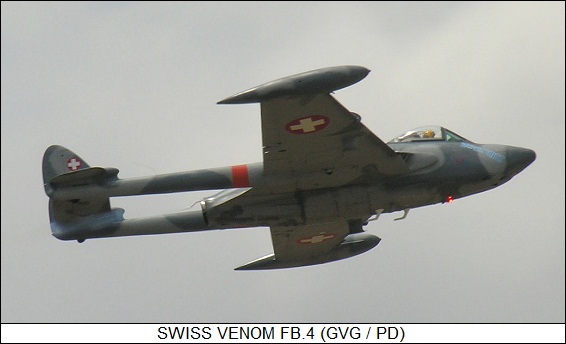
* The Vampire was a remarkable success and an excellent aircraft, but since it was only Britain's second operational combat jet after the Gloster Meteor, there was obvious room for improvement. De Havilland engineers had been working on a more powerful centrifugal-flow engine named the "Ghost" to follow the Goblin, and also had ideas for aerodynamic refinements.
A Vampire refitted with a Ghost on a trials basis broke the world altitude record in May 1947, and the Air Ministry, impressed, funded development of the improved variant, the "DH.112", originally to be designated the "Vampire FB.8". Two prototypes, conversions of Vampire FB.5s, were built, with the first flying on 2 September 1949, with John Derry at the controls. It was ready just in time to attend the Farnborough air show. By that time, the decision had been made that the DH.112 was such a step ahead of the Vampire that it needed to be given a new name, and was christened "Venom" -- the original name "Valkyrie" having been rejected.
The second prototype performed its initial flight on 23 July 1950. The first production "Venom FB.1" was rolled out in 1951, but manufacturing dislocations delayed full production until mid-1952. The Venom FB.1 went into service with RAF Germany in the summer of 1952.
* The Venom had much the same configuration as the Vampire, so much so that the two aircraft could be confused at a casual glance, particularly from the side. The major external difference was the Venom's wing, which was thinner and featured a shallow leading-edge sweepback; midwing "fences"; plus distinctive fixed wingtip fuel tanks with a small horizontal fin at the outside rear, as well as a strake on the inside front. The tailfins were curved and featured acorn fairings at the junction with the tailplane; the tailplane extended outside of the tailfins.
The new wing was required to make use of the additional power provided by the Ghost 103 engine, which could produce 21.6 kN (2,200 kgp / 4,850 lbf) thrust, about half again as powerful as the Goblin, while being about the same size and weight. The new engine fit required a small but noticeable auxiliary intake on the aircraft's back.
The Venom retained the quad 20-millimeter Hispano V cannon armament of the Vampire, as well as the Vampire's underwing stores capacity of 900 kilograms (2,000 pounds). Typical weapons load was two 450-kilogram (1,000-pound) bombs or eight RPs; a drop tank could be carried under each wing as an alternate payload. The Venom retained the Vampire's agility and friendly handling characteristics, but was faster and in particular had a much improved rate of climb. Roll rate of course suffered when the wingtip tanks were full.
The Venom was more than a match for the Vampire and the US Republic F-84 Thunderjet, and could probably outfly the US Lockheed F-80 Shooting Star. However, the Venom was still effectively a first-generation jet fighter, and not the equal of the second-generation US North American F-86 Sabre or Soviet MiG-15.
___________________________________________________________________
DE HAVILLAND VENOM FB.1:
___________________________________________________________________
wingspan over tanks:
12.7 meters (41 feet 8 inches)
wing area:
26 sq_meters (280 sq_feet)
length:
9.71 meters (31 feet 10 inches)
height:
1.88 meters (6 feet 2 inches)
empty weight:
3,674 kilograms (8,100 pounds)
loaded weight:
6,945 kilograms (15,310 pounds)
maximum speed:
1,030 KPH (640 MPH / 555 KT)
service ceiling:
13,720 meters (45,000 feet)
range:
1,730 kilometers (1,075 MI / 935 NMI)
___________________________________________________________________
* A total of 373 Venom FB.1s was built for the RAF, not counting the two prototypes. Following introduction to service with RAF Germany, the FB.1 was provided to RAF units in the Middle East, beginning in Jordan in February 1954. Eventually the FB.1 replaced the Vampire in RAF service in the Middle and Far East, serving in far-off duty posts such as Singapore and Hong Kong.
The Venom FB.1 had initially suffered from structural failures and engine fires, which led to some losses and urgent engineering efforts to find fixes. The losses did shine light on a major flaw of the FB.1: no ejection seat. Pilots didn't like this omission at all, and were also unhappy about the lack of air conditioning, which made the cockpit a "hotbox" in warm climates. De Havilland implemented the needed improvements, resulting in the first flight of the "Venom FB.4" on 29 December 1953.
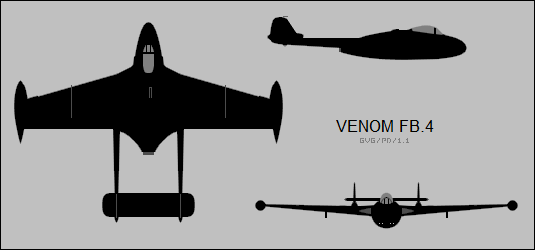
The Venom FB.4 featured a Martin Baker Mark 1F ejection seat, a Godfrey air-conditioning system, larger squared-off tailfins with acorn fairings that protruded out the back, plus power-boosted ailerons and rudders. The power-boosted ailerons gave a good rate of roll even with full wingtip tanks. However, by 1953 even an improved Venom was "old news", and the RAF really needed a more modern fighter -- which would be obtained in the form of the Hawker Hunter.
A total of only 150 FB.4s was built for the RAF between 1954 and 1957. The FB.4 reached RAF squadron service, again in Germany, in the summer of 1955. Most RAF Venom FB.1 units were eventually upgraded to the FB.4. RAF FB.4s saw combat during Operation MUSKETEER, the Anglo-French-Israeli seizure of the Suez Canal in the fall of 1956, attacking Egyptian airfields, and they were also flown in combat during the uprising in Oman in the summer of 1957. FB.4s stayed on in RAF service in the ground attack role into the early 1960s. The last RAF unit to operate Venoms, 28 Squadron, phased them out in favor of the Hunter FGA.9 in 1962.
* Since the Venom lagged the times, it didn't have the same export success as the Vampire, but there were still a number of foreign users. Iraq obtained 15 "Venom FB.50" machines in 1954:1956, with illustrations showing them to have FB.1-style tailfins. Venezuela bought 22 "FB.54s" in 1955, with these machines being basically FB.4s and remaining in service into the early 1970s.
The Swiss, who had liked the Vampire a good deal, were the biggest export customer for the Venom. 150 FB.1s and 100 FB.4s were built at Emmen; the Ghost engines were built by the Swiss production group and by Fiat of Italy. Some sources claim that all the Swiss machines were also known as FB.50s, though usually export variants of British aircraft had designations specific to the particular national customer.
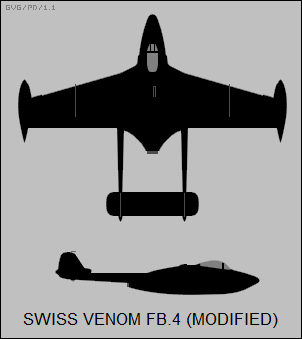
The Swiss Venoms remained in service until the early 1980s, with a series of upgrades in kit during that time. The most distinctive upgrade was fit of the longer, turned-up nose used on some Swiss Vampires, but the Venoms were also fitted for carriage of a wider range of ordnance, as well as an underwing multi-sensor reconnaissance pod. After retirement, a number of the Swiss Venoms were acquired by warbird collectors, and the "long-nose" Swiss Venoms are a popular attraction at airshows in the 21st century.
BACK_TO_TOP* De Havilland also built a two-seat night-fighter version of the Venom, essentially mating the fuselage of the Vampire NF.10 to the Venom wings, and adding relatively large tailfins. The Air Ministry expressed little interest in the concept; de Havilland went ahead anyway and built a prototype using company funds, with this aircraft performing its first flight on 22 August 1950. The RAF judged the type unspectacular and was particularly unhappy about the lack of ejection seats, but it was still better than the service's current Armstrong Whitworth Meteor and Vampire NF.10 night fighters -- and so 90 were obtained with the designation of "Venom NF.2", the first flying on 4 March 1953.
Service introduction was in November 1953. The NF.2 was powered by the de Havilland Ghost 104 turbojet with 22.0 kN (2,245 kgp / 4,950 lbf) thrust. A single squadron flew the type, finding it an improvement over their previous mount, the Vampire NF.10, but the Venom NF.2 suffered teething problems in service that took some effort to work out. Later production featured the frameless canopy and raked tailfins of the Vampire T.11. Machines featuring this fit were designated "NF.2A"; some sources claim that a number of NF.2s were upgraded to NF.2A standard as well.
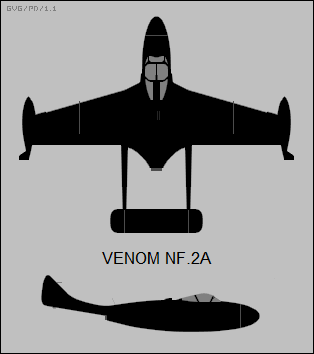
Real fixes for the deficiencies of the type required more extensive effort, leading to the "Venom NF.3", with first flight of a prototype on 22 February 1953. The Air Ministry ordered 129 production machines, with the first delivered to the RAF in mid-1955. The major improvement was AI.21 radar, which was a Westinghouse AN/APS-57 radar supplied under the US Military Assistance Program. Other fixes included a hinge-up radome, replacing the slide-off radome of the NF.2; powered ailerons to improve the roll rate; new alternators; and various aerodynamic improvements. Ejection seats were not fitted, apparently because of the difficulty of building ejection seats that could operate safely in a side-by-side cockpit -- though a powered canopy jettison system was added.
Eventually the NF.2, NF.2A, and NF.3 equipped a total of seven squadrons. They had a short service life, however, with the last of them phased out in late 1957 in favor of the Gloster Javelin.
* The Swedes also purchased the Venom night fighter under the export designation "Venom NF.51", and in fact they were the first of the two-seat Venoms to enter service, with initial deliveries in December 1952. The Flygvapnet obtained 62 NF.51s, giving them the local designation of "J33". They were all powered by a with a license-built copy of the Ghost, the "RM2A", with the engines shipped to the UK for final fit into the British-built airframes.
The first 30 of the batch were equivalent to early production NF.2s, with the last 32 featuring the new canopy and tail of the NF.2A; upgrade kits were supplied to bring the first 30 up to the same standard. They were finally phased out of Flygvapnet service in 1960, though four were handed over to a civilian contractor for use as target tugs, with the last retired in 1971.
BACK_TO_TOP* The Royal Navy was interested in the Venom NF.2 as a replacement for the de Havilland Sea Hornet. The NF.2 prototype was evaluated by the FAA, performing carrier "touch-&-go" approaches to determine its suitability for carrier operations.
The trials went well enough to lead to construction of three prototypes of a navalized NF.2. The first, designated "Sea Venom NF.20", performed its initial flight 19 April 1951. It was generally similar to the NF.2, but featured strengthening for catapult operation and an arresting hook. The hook was in a yoke configuration and swung down from an extended "lip" above the engine exhaust through the exhaust flow. The second prototype added long-stroke landing gear and featured the tailfin arrangement of the Venom NF.3, while the third added wings that hydraulically folded straight up outboard of the wing fences.
The first of 50 production "Sea Venom FAW (Fighter All Weather) 20" aircraft performed its initial flight in March 1953. These machines featured the Ghost 103 engine, AI.10 radar, and a clear-view canopy like that introduced on the NF.2A, but modified to allow it to be jettisoned underwater. They didn't have power-boosted flight controls. The FAW.20 entered FAA service in 1954.
De Havilland worked hard to improve the type, with the first of 167 "Sea Venom FAW.21" machines performing its initial flight on 22 April 1954. The FAW.21 featured a Ghost 104 engine, Westinghouse AI.21 radar, a canopy with a bulged top to improve headroom, power boosted rudders and ailerons, nonskid brakes, and inflatable seat packs to assist in underwater escapes. The tailplane extensions outboard of the tailfins were deleted. Martin Baker Mark 4A ejection seats were fitted in the 100th machine; it is unclear if they were retrofitted to earlier production.
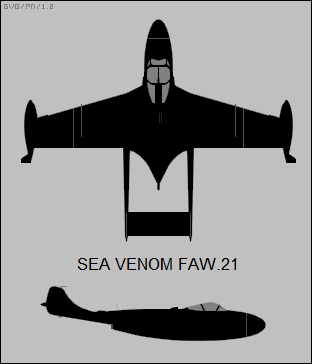
The last FAW.21 was rolled out in 1957, but Sea Venom production wasn't quite finished yet, with 39 more "Sea Venom FAW.22" machines built in 1957 and 1958. They featured a Ghost 105 engine, with 23.0 kN (2,335 kgp / 5,150 lbf) thrust, and improved AI.22 radar; many FAW.22s were fitted after delivery to carry DH Blue Jay (later Firestreak) heat-seeking air-to-air missiles (AAM), making them the first FAA machines with guided AAM armament.
The Royal Navy obtained a total of 256 Sea Venoms of all types. Sea Venoms participated in Operation MUSKETEER in 1956, with aircraft operating off the HMS ALBION and HMS EAGLE in the ground attack role. The Sea Venoms hit Egyptian vehicles, barracks, and communications with bombs, rockets, and cannon fire.
* In 1946, the French Aeronavale had issued a request for a shipboard jet fighter, with three aircraft designed in response: the Nord 2200, the Aerocentre NC-1080, and Arsenal VG-90. For various reasons, none of these aircraft proved satisfactory, and the Aeronavale began to cast around for alternatives. The service considered the Grumman F9F-6 Panther, but in January 1951 finally settled on the Sea Venom FAW.20, which was then in development. Arrangements were made for license manufacture by Sud-Est, with the aircraft given the name of "Aquilon (North Wind)".
Sud-Est began with four "kitted" FAW.20s shipped from de Havilland and assembled them, with the first of the four flying on 20 February 1952. These led to 25 "Aquilon 20" machines built to a similar specification. Improvements were desired, however, with a single prototype "Aquilon 201" fitted with ejection seats and a new sliding canopy. The ejection seats were built by Sud-Est; some sources claim they were a Martin-Baker design built under license, others state that they were an original Sud-Est design.
The initial full-specification production machine was the "Aquilon 202", the first performing its initial flight on 25 March 1954, and a total of 25 built. It featured the ejection seats and sliding canopy trialed on the single Aquilon 201, but added antiskid brakes and a Derveaux DRAX-4A radar rangefinder. The aircraft was powered by a Fiat-built Ghost 48 Mark I engine with 21.6 kN (2,200 kgp / 4,850 lbf) thrust. The armament of quad Hispano cannon was retained.
The "Aquilon 203" was similar, but featured US-built AN/APQ-65 radar. The radar and power generation kit was so bulky that it demanded removal of the second seat. The Aquilon 201 machine was modified as the Aquilon 203 prototype, with 40 production Aquilon 203s following. The Aquilon 203 was fitted to launch the Nord 5103 / AA.20 radio-guided AAM, with one carried under each wing. The improved R.511 semi-active radar homing AAM was supported later, as were AS-20 air-to-surface missiles. Aquilon 203s saw some combat against the insurgency in Algeria in the ground-support role, using cannon and various types of unguided rockets.
Six of the Aquilon 20s were modified as "Aquilon 204" radar trainers by being stripped of armament and fitted with the AN/APQ-65 radar. Removal of the armament permitted fit of a second seat for a trainee. They were of course not combat-capable. The Aquilons were generally out of service by 1960, apparently lingering on in training roles for a few more years.
A total of 1,431 Venoms was built. Single-seat production was 810 aircraft, variants including:
Two-seater production was 621 aircraft, variants including:
* While DH was producing the Vampire, company engineers were considering similar design concepts for a larger and more advanced fighter, the "DH.110", in response to an RAF requirement for a jet-powered, twin-engine, two-seat night fighter to replace Mosquito night fighters. The requirement was issued as "Specification F44/46" in early 1947; the Royal Navy also had a requirement for an all-weather fighter, issued under "Specification N40/46", that was similar in some ways, and de Havilland submitted variations of the DH.110 as solutions.
The DH.110 was selected for the F44/46 requirement in the spring of 1947, with three prototypes ordered. The requirement was reconsidered somewhat in mid-1948 and reissued as "Specification F4/48", with the program further reconsidered later in that year to also cover the naval N40/46 requirement, with one of the three prototypes to be built as a naval fighter. There was even more shuffling in 1949, with the naval requirement changed to "Specification N14/49" and the program covering several more variants, including a long-range reconnaissance / strike variant, leading to a total prototype order of 13 machines.
The entire exercise ended up as confused as it sounds, with the Royal Navy pulling out of the program, and all the additional variants given the axe. In the end only two prototypes were actually built, both for the RAF F4/48 requirement. The first, WG236, was fitted with twin Rolls-Royce Avon RA.3 axial flow turbojets providing 28.9 kN (2,950 kgp / 6,500 lbf) thrust each. It performed its initial flight on 26 September 1951, with John Cunningham at the controls, and broke Mach 1 in a dive on 9 April 1952, the pilot being John Derry and the observer Tony Richards. An American team helped evaluate the machine later that spring, being generally impressed by the aircraft but pointing out deficiencies, most significantly heavy controls.
The second prototype, WG240, performed its first flight on 25 July 1952. It had substantially more powerful Avon RA.7 engines, providing 33.3 kN (3,400 kgp / 7,500 lbf) thrust each. John Derry provided glowing reports of the machine's performance, with fast acceleration and a fast rate of the climb, but the program was just about to collide with disaster.
On 6 September 1952, Derry and Richards were running WG236 through its paces at the Farnborough air show when it simply shed its wings. Both aircrew were killed; worse, the aircraft plowed into the crowd, killing 27 and injuring 63. It was one of the worst airshow accidents in British aviation history. The second prototype's wings were reinforced and the flight test program seemed to be going well, but in late October the RAF, possibly influenced by the public taint of the airshow disaster, selected the Gloster Javelin as the solution to the night-fighter requirement.
* That might have been the end of the DH.110, but the FAA still had an outstanding requirement for an all-weather fighter. The Sea Venom was being obtained as an interim fix, but it was obviously going to be obsolete in a few years, and the Royal Navy had been casting around for a long-term solution, issuing a series of requests from early 1951.
A number of aircraft manufacturers submitted proposals. In September 1951, de Havilland had offered a "DH.116 Super Venom", a major redesign of the two-seat Venom, really not doing much more than retaining the forward fuselage and cockpit, attached to an entirely new airframe that abandoned the twin-boom format for a more conventional arrangement with swept flight surfaces.
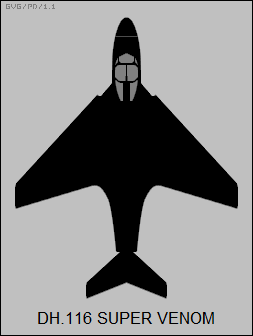
It was an attractive idea and the Royal Navy was interested -- but a year later de Havilland had to backtrack, pleading lack of engineering design resources. The company offered an update of the navalized DH.110; the Royal Navy was agreeable, performing initial studies in early 1953, with the design being selected for further development in early 1954, as the "DH.110(N)", conforming to "Specification N.139P". De Havilland also worked on a scaled-up DH.110 derivative for a naval strike requirement, but the FAA would select the excellent Blackburn Buccaneer instead. The DH.110(N) featured a larger nose to accommodate GE AI.18 radar, and was navalized with power folding wings, heavier landing gear (including a steerable nosewheel), and an arresting hook.
The second DH.110 prototype, WG240, conducted test flights for the DH.110(N) program, for example performing "touch and go" carrier approaches to determine the aircraft's handling for the job. Work on a navalized prototype was revived in parallel, with the third aircraft, XF828, performing its first flight on 20 June 1955, with "Jock" Elliot at the controls. It lacked the folding wings and reinforced landing gear intended for production aircraft. Carrier trials were complete by April 1956.
BACK_TO_TOP* The first fully kitted production aircraft, designated the "Sea Vixen Fighter All Weather (FAW) 1", performed its initial flight on 20 March 1957. There had been some inclination to name it the "Pirate", but the "Vixen" name had been loosely attached to the DH.110 since 1949, and won out. FAA Number 892 squadron was the first to form up with the type, in July 1959, with the squadron performing its first cruise with the type on the HMS ARK ROYAL in March 1960. A total of 119 FAW.1s was delivered in all.
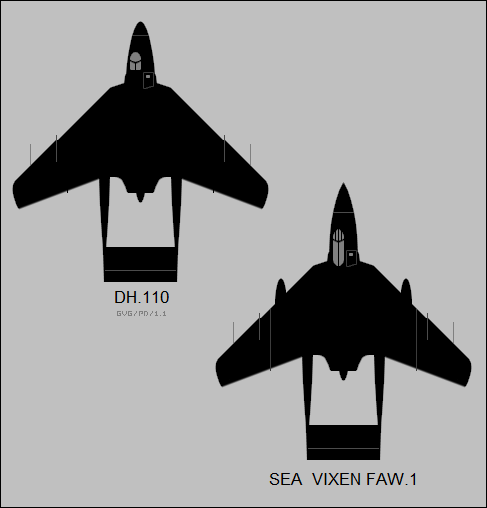
The Sea Vixen FAW.1 was by no means an improved Venom, in the way that the Venom was unarguably an improved Vampire. The Sea Vixen was an entirely new aircraft that only retained the twin-boom general configuration of the Vampire / Venom. It had swept wings, more or less derived from the DH.108, that folded up outboard of the tailbooms. Each wing featured a small Fowler flap inboard of the tailboom, with a larger Fowler flap just beyond the wing fold, and then an aileron; there was a prominent wing fence across the outer leading edge.
It also had swept tailfins, with the tailplane mounted high. The tailplane was "all moving" and straight, though early design concepts for the DH.110 had visualized it as a forward-swept or reverse-swept vee surface. The tailplane did have a hinged rear flight surface, but it wasn't used for pitch control, instead being used to maintain trim while the flaps were down. There was a single-piece airbrake under the fuselage; there were no trim tabs, trim being maintained by adjusting the tailplane, right rudder, and right aileron.
The landing gear was in tricycle configuration, with landing gear assemblies featuring single wheels -- the main gear hinging in from the wings towards the fuselage, and the nose gear retracting backward. The nose wheel was steerable. There was a stinger-type arresting hook under the tail. The flight controls and landing gear were hydraulically actuated, with dual independent hydraulic systems to ensure reliability, and a ram-air turbine (RAT) to provide hydraulic power to one of the systems in case the pumps of both failed. AI.18 radar was fitted in the nose, with the nosecone hinging open to the right.
The Sea Vixen was powered by twin Rolls-Royce Avon 208 turbojets, providing 50 kN (5,100 kgp / 11,230 lbf) thrust each. Among the reasons for using the twin-boom scheme was that it allowed the two engines to be placed closely together, reducing the problems of asymmetrical thrust if one engine failed, and it also improved service access to the engines.
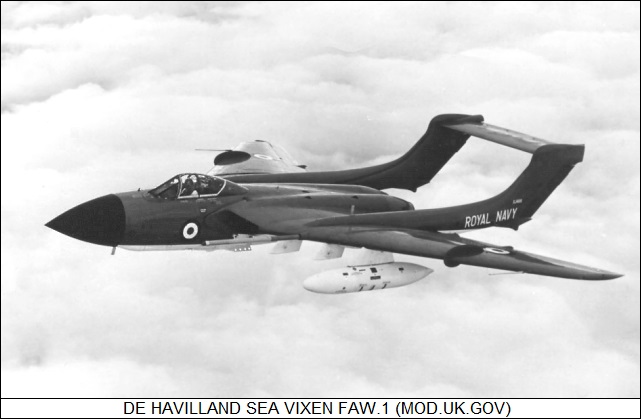
The cockpit arrangement was distinctively British, with:
Early concepts had also featured a side-by-side cockpit much like that of the Sea Venom, but the decision was made that the radar operator would be able to see his displays better from inside the dark "coal hole" or "coal bin" than from under cockpit glazing. The narrower canopy also reduced drag, though it did affect the aircraft's yaw trim somewhat.
The Sea Vixen was the first British fighter with all-missile armament -- a concept that was popular at the time, since there was a general notion that the new guided missiles had made dogfighting obsolete. The FAW.1 was armed with four de Havilland Blue Jay / Firestreak heat-seeking missiles, carried on four underwing pylons, plus two retractable packs under the fuselage that carried a total of 28 Microcell 2-inch (5.08-centimeter) folding-fin aircraft rockets (FFAR). Along with the four pylons for the Firestreaks, there was a pylon under each wing for an external tank.
Air-to-ground ordnance, such as bombs and rocket packs, could be carried as well, and the Sea Vixen was eventually qualified with the US Bullpup radio-guided air-to-surface missile. The Bullpup required that the launch platform carry a radio guidance link; it is unclear if this was fitted internally or in a pod carried on a stores pylon. The Bullpup wasn't a very effective weapon, and it is unclear how often it was carried.
Early DH.110 concepts had envisioned four 20-millimeter Hispano cannon, or two Aden 30-millimeter revolver cannon, or even a 114-millimeter (4.5-inch) recoilless cannon that the British were infatuated with for a period of time. The big gun fired a proximity-fuzed shell and eliminated recoil by firing a counterweight out the back, while the shell went out the front. "Countershot" guns had been considered by several nations since WWI, but they were never seriously used operationally. In the end, no cannon were fitted to the Sea Vixen. Deleting the cannon wasn't a good idea, since the whizzy guided missiles of the era would not turn out to be all that whizzy in actual combat.
* However, the Sea Vixen FAW.1 was appreciated by FAA aircrews, since it had twice the rate of climb of the Sea Venom, and also had a much higher service ceiling and greater operational endurance. It was agile for its size and handled well even with full external stores, and pilots came across few handling peculiarities.
In 1961, the decision was made to acquire the "Sea Vixen FAW.2", which was to carry the improved Red Top AAM. Fuel supply was increased by modifying the tailbooms, deepening them and distinctively extending them in front of the leading edge of the wing. The original proposal was to fit the FAW.2 with Rolls-Royce RB.168 engines, with about the same thrust but lighter weight and much better fuel economy than the Avons; however, the Avon 208 engines were retained. Pictures of the FAW.2 show an extensible inflight refueling probe on the leading edge of the right wing, just outboard of the tailboom. A picture survives of an FAW.1 fitted with the probe as well and carrying a buddy refueling pack, but this appears to have been a trials fit.
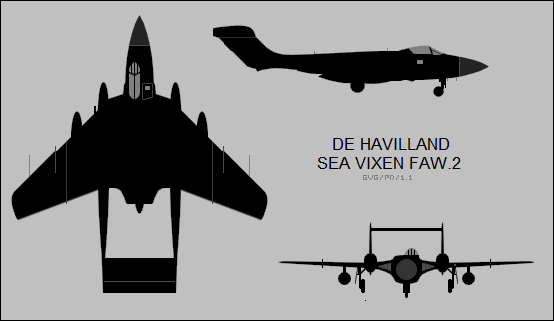
Two FAW.1s were modified as initial FAW.2 prototypes, with the first performing its maiden flight on 1 June 1962, with Chris Capper at the controls. Following delivery of the last FAW.1 in December 1962, the last 14 FAW.1s on order were upgraded in production and delivered as FAW.2s, with the first full-spec FAW.2 performing its initial flight on 8 March 1963. 15 new-build FAW.2s were completed after that, with deliveries to 1966. These were the last of 151 Sea Vixens of all variants completed, including the three prototypes; the type was never exported, and all operational aircraft served solely with the FAA. Between 1963 and 1968, 67 of the FAW.1s were updated to FAW.2 standard by Hawker Siddeley, which had absorbed de Havilland.
___________________________________________________________________
DE HAVILLAND SEA VIXEN FAW.2:
___________________________________________________________________
wingspan:
15.5 meters (51 feet)
wing area:
60.2 sq_meters (648 sq_feet)
length:
16.94 meters (55 feet 7 inches)
height:
3.28 meters (10 feet 9 inches)
empty weight:
11,795 kilograms (26,000 pounds)
MTO weight:
16,785 kilograms (37,000 pounds)
maximum speed:
1,030 KPH (640 MPH / 555 KT)
service ceiling:
14,630 meters (48,000 feet)
range:
1,930 kilometers (1,200 MI / 1,045 NMI)
___________________________________________________________________
FAA Squadron Number 899 was the first to receive the FAW.2, in December 1963, with the type performing its first cruise on the HMS EAGLE in 1964. The next year the Sea Vixen was on combat air patrol in the Indian Ocean near Mozambique, assisting in sanctions / blockade operations against Rhodesia. Other FAA squadrons were re-equipping with the Sea Vixen in the meantime, with the last, Number 890, converting in August 1967.
Unfortunately, by that time the Sea Vixen's days were clearly numbered, since the British government had decided to phase out the Royal Navy's carriers in 1966. Number 899 Squadron was the last to disband, in January 1972. It had never fired a shot in anger in service.
Some Sea Vixens lingered on as test and trials machines, and three were converted to "Sea Vixen D.3" target drones by Flight Refueling LTD, starting in 1972. More were to have been converted to drones, but the program stalled, mostly due to cost -- but also, apparently, because the Sea Vixen was so different in appearance to any operational Eastern bloc aircraft, and indeed there weren't many aircraft anywhere that looked like it. One of the D.3s is now in the hands of the European "Red Bull" private warbird flight collection, and makes piloted appearances at airshows.
* The Sea Vixen retains something of a reputation as an outdated aircraft that was put into service too late. That judgement is hard to argue as far as it goes -- by the time it had reached full operational service, combat aircraft technology was clearly moving on to Mach 2 technology -- but had the Sea Vixen been fielded just a few years earlier that wouldn't have been an issue. Since the limiting factor on its service was the retirement of the Royal Navy's carriers, it would have been retired at about the same time anyway.
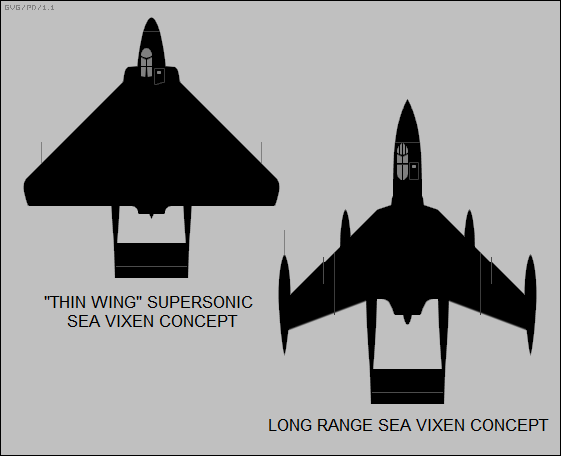
Judged on its own merits, it was a fine and memorable aircraft. Like so many British aircraft of its era, probably more could have been made of it had the will been there. The long-range strike / reconnaissance concepts have already been mentioned, and there were also supersonic "thin wing" designs, though the conclusion was that they required so many airframe changes that it would be better to come up with a "clean sheet" design instead. Less ambitious improvements were considered as well, including much better engines, new AAMs, and new radar. Unfortunately, the late 1950s and the 1960s were an era of disappointments for everyone associated with British combat aviation, with the sense of frustration lingering to this day.
A total of 151 Sea Vixens was produced, variants including:
* Sources include:
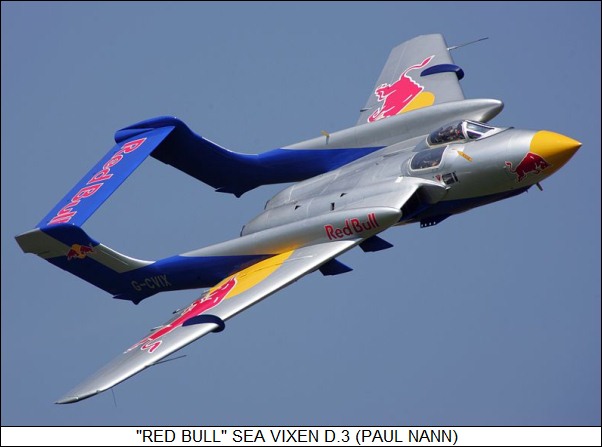
* Revision history:
v1.0.0 / 01 jul 05 v1.0.1 / 01 apr 07 / Review & polish. v1.0.2 / 01 apr 09 / Review & polish. v1.0.3 / 01 oct 10 / Review & polish. v1.0.4 / 01 sep 12 / Review & polish, photo update. v1.0.5 / 01 jun 14 / Review & polish. v1.0.6 / 01 may 16 / Review & polish. v1.0.7 / 01 apr 18 / Review & polish. v1.0.8 / 01 feb 20 / Review & polish. v1.0.9 / 01 dec 21 / Review & polish. v1.1.0 / 01 nov 23 / Review & polish. v1.1.1 / 01 nov 25 / Review & polish.BACK_TO_TOP
